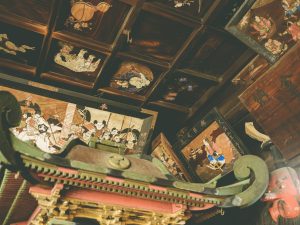
Land of Hidden Treasures
While Tanushimaru's temples, such as Ishikakizan Kannon-ji, which enshrines the wooden statue of Bishamonten, a designated cultural property of Fukuoka Prefecture, are known for their impressive collection of Buddhist statues and paintings, the humble shrines scattered throughout the region also hold a wealth of hidden treasures.
Remarkable Votive Offerings
Dating back to the Edo period to the Showa era, many shrines in Tanushimaru proudly display large and small votive tablets (hōnōgaku). These offerings were often presented to commemorate pilgrimages to Ise Shrine and typically depict famous historical scenes, such as the Empress Jingu's naval battle against Silla, a theme relevant to the Chikugo area, or the Seven Spears of Shizugatake, or the Funeral at Daitokuji Temple, both associated with Toyotomi Hideyoshi. Some shrines even showcase the waka-e paintings of Sanjūrokkasen (the Thirty-Six Immortals of Poetry) showing their legendary figures with their famous poetry aside .
Glimpses of History Unveiled
In shrines with closed doors, these votive tablets remain hidden from view, only revealed on ceremonial days. However, in shrines without doors, visitors can admire them simply by standing in front of the offertory box to pray. Yet, this constant exposure to the elements has taken a toll on the paintings, necessitating urgent research and conservation efforts.


Rising High: The Shrine Banner (Nobori)
On ceremonial days, one can witness the soaring white shrine banner (nobori) proudly displayed within the shrine grounds. In Tanushimaru, most nobori feature bold black calligraphy, not the shrine's name, but sen-yō-bun (prayer or poem) in the style of Chinese poetry. These sen-yō-bun differ from shrine to shrine, making shrine hopping even more fascinating as you decipher their meanings.
Preserving Traditions: The Upholding of Flagpoles
While most shrines utilize flagpoles to hoist their nobori banner, a few remarkable shrines still uphold the age-old tradition of manually erecting flag posts using manpower. With the dwindling number of shrine patrons and their aging population, it remains uncertain how long this practice can be sustained. In this day and age, the very act of raising flag posts has become a precious historical heritage in itself.
A Tapestry of History: Uncovering Shrines' Treasures
Beyond the nobori banner, a myriad of historical gems awaits discovery within the shrines of Tanushimaru. From lion heads used in Shishimai (lion dance) to deity statues depicting kappa (water spirits), intricate stone lanterns and relief sculptures on shrines, each element tells a story of the past. Additionally, ancient documents such as zachō (ceremonial records), which detail the procedures for shrine rituals, offer invaluable insights into the bygone practices of these sacred traditions.


